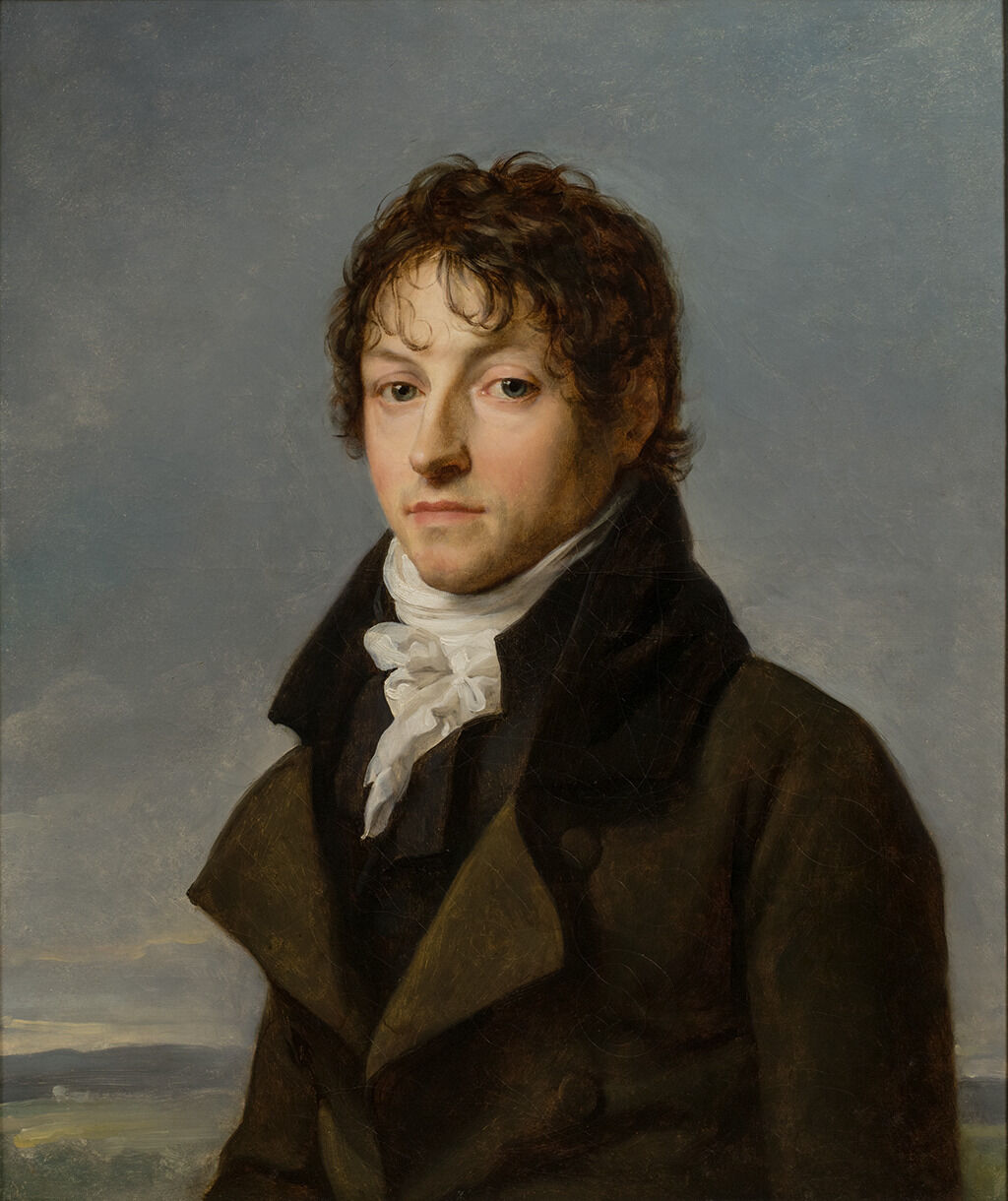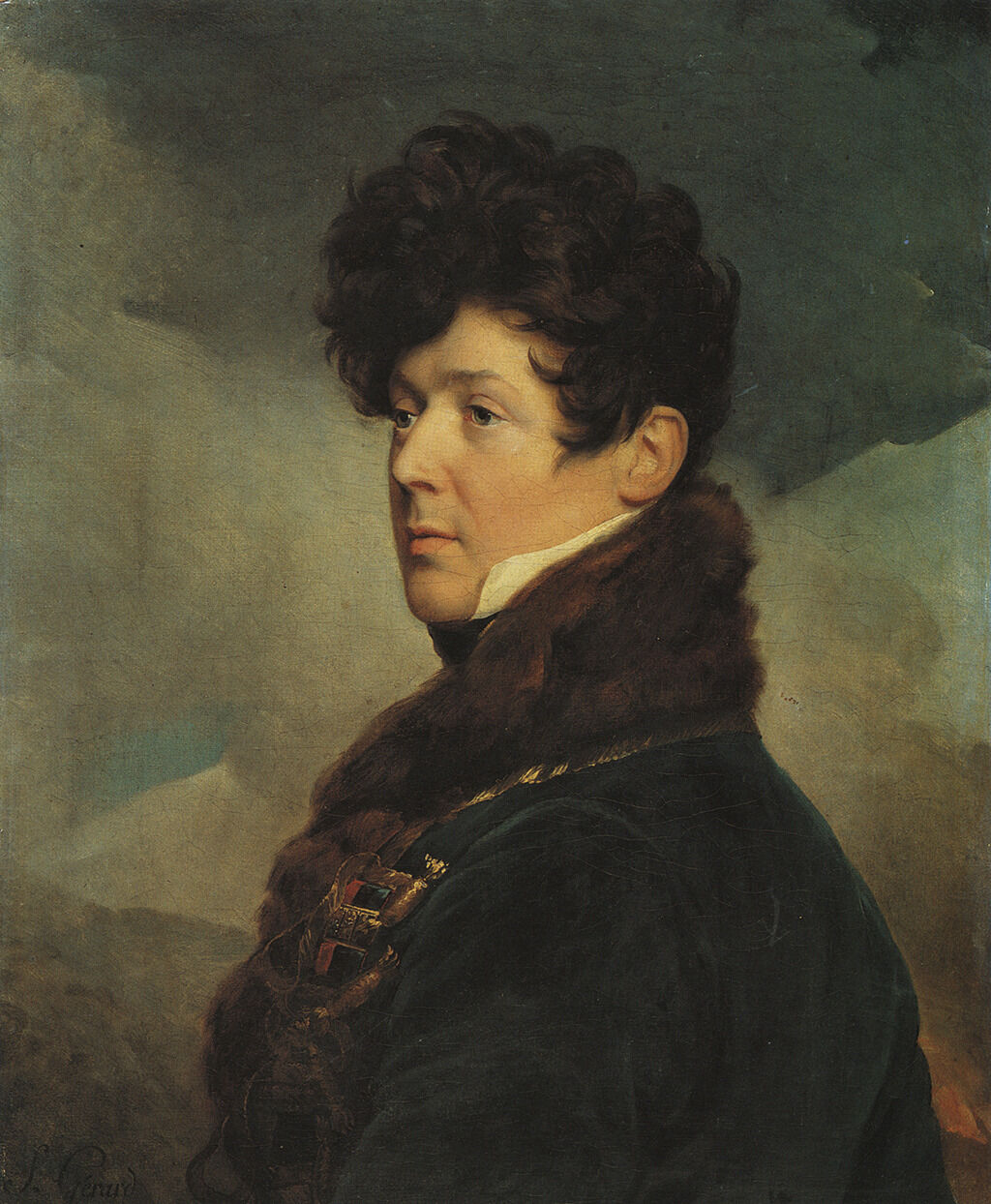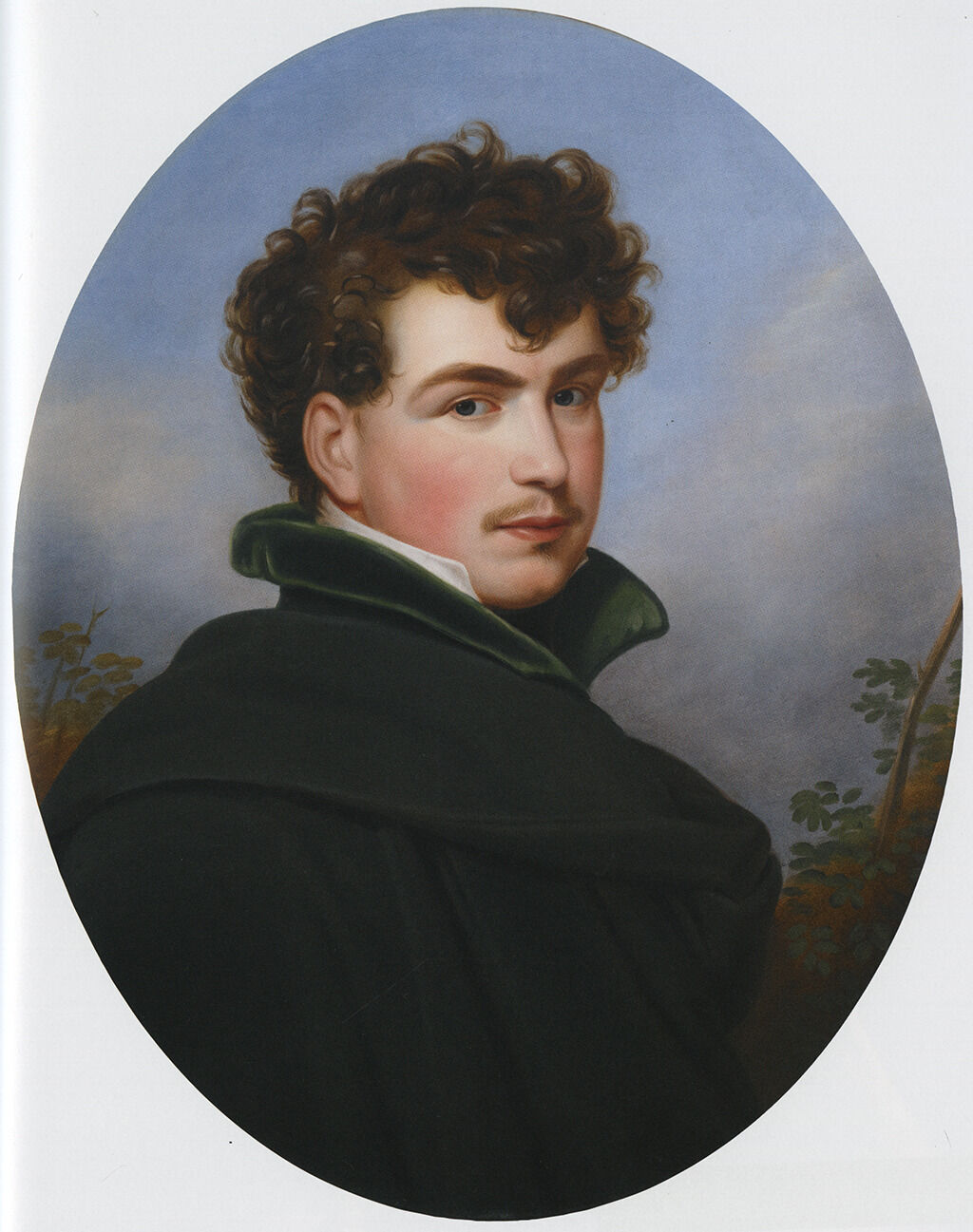![]()
Attributed to Joseph Karl Stieler, Portrait of a Gentleman, ca. 1815
| Artist | Attributed to Joseph Karl Stieler, German, 1781–1858 |
| Former Attribution | Baron François Gérard, French, 1770–1837 |
| Title | Portrait of a Gentleman |
| Object Date | ca. 1815 |
| Medium | Oil on canvas |
| Dimensions (Unframed) | 25 9/16 x 21 1/8 in. (64.9 x 53.7 cm) |
| Credit Line | The Nelson-Atkins Museum of Art. Purchase: William Rockhill Nelson Trust, 35-38/2 |
Catalogue Entry
Citation
Chicago:
Kathryn Calley Galitz, “Attributed to Joseph Karl Stieler, Portrait of a Gentleman, ca. 1815,” catalogue entry in French Paintings and Pastels, 1600–1945: The Collections of the Nelson-Atkins Museum of Art, ed. Aimee Marcereau DeGalan (Kansas City: The Nelson-Atkins Museum of Art, 2024), https://doi.org/10.37764/78973.5.419.5407.
MLA:
Galitz, Kathryn Calley. “Attributed to Joseph Karl Stieler, Portrait of a Gentleman, ca. 1815,” catalogue entry. French Paintings and Pastels and Pastels, 1600–1945: The Collections of The Nelson-Atkins Museum of Art, edited by Aimee Marcereau DeGalan, Nelson-Atkins Museum of Art, 2024. doi: 10.37764/78973.5.419.5407.
Neither signed nor dated, this portrait of an unidentified man was probably painted around 1815. The sitter’s dress and hairstyle conform to men’s fashions of this date, as documented in contemporaneous portraits of French and British sitters.1In an email of March 15, 2013, to the author, Aileen Ribeiro, professor emerita, Courtauld Institute of Art, suggested a date of ca. 1815, based on the sitter’s hussar-influenced frockcoat, similar to one in Jean Auguste Dominique Ingres (1780–1867)’s 1816 portrait drawing of Sir John Hay and his sister Mary (British Museum, London). The green wool coat fastened with braided loops, or froggingfrogging: Ornamental braid or coat fastenings with spindle-shaped buttons and loops., reflects the influence of hussar uniforms and was in vogue during the Napoleonic era. The sitter’s curly auburn hair, worn in a variation of the classicizing style à la Titus popularized in the 1790s, is made modern by the long sideburns.2See Aileen Ribeiro, The Art of Dress: Fashion in England and France 1750–1820 (New Haven: Yale University Press, 1995), 104–9. He sports an insignia mounted on a gold bar, or bavette, of a type worn in the second decade of the nineteenth century to denote membership in an order active in France, the Netherlands, and present-day Belgium. The order itself, represented by a five-pointed white star surmounted by what appears to be a crown, has eluded identification to this date.3I thank Stephen Patterson of the Royal Collection Trust for his assistance in attempting to identify the order, as conveyed in an email to the author of April 13, 2019.



Notes
-
In an email of March 15, 2013, to the author, Aileen Ribeiro, professor emerita, Courtauld Institute of Art, suggested a date of ca. 1815, based on the sitter’s hussar-influenced frockcoat, similar to one in Jean Auguste Dominique Ingres (1780–1867)’s 1816 portrait drawing of Sir John Hay and his sister Mary (British Museum, London).
-
See Aileen Ribeiro, The Art of Dress: Fashion in England and France 1750–1820 (New Haven: Yale University Press, 1995), 104–9.
-
I thank Stephen Patterson of the Royal Collection Trust for his assistance in attempting to identify the order, as conveyed in an email to the author of April 13, 2019.
-
Comparable works include Jean Auguste Dominique Ingres’s Baron Joseph Pierre Vialetès de Montarieu (1805–6; Norton Simon Museum, Pasadena, CA), as suggested by Richard Rand, as well as Antoine Jean Gros (1771–1835), Count Honoré de La Riboisière (1815; private collection).
-
On Gérard’s portraits, see Kathryn Calley Galitz, “François Gérard: Portraiture, Scandal, and the Art of Power in Napoleonic France,” Metropolitan Museum of Art Bulletin 71, no. 1 (2013): 5–48; and Xavier Salmon, Peintre des rois, roi des peintres: François Gérard (1770–1837), Portraitiste (Paris: Réunion des musées nationaux-Grand Palais, 2014).
-
Other examples of portraits in this format by Gérard include Général Horace Sebastiani (1806) and Général Antoine Charles Louis, comte de Lasalle (1808). Both are reproduced as engravings in [Henri Gérard], Oeuvre du Baron François Gérard, 1789–1836: Gravures à l’eau forte (Paris: Vignères et Rapilly, 1857), unpaginated.
-
Alain Latreille, who is currently preparing a catalogue raisonné of the artist’s work, rejected the attribution to Gérard based on a photograph of the work in an email to the author of April 12, 2013, as did Udo Felbinger, author of “François Gérard und das französische Porträt 1795–1815” (PhD diss., Freie Universität, Berlin, 1999), in an email to the author of September 14, 2013. Felbinger suggested that the work is by a student of Jacques Louis David.
-
See technical notes by Nathan Sutton, paintings conservation graduate intern, January 28, 2010, with additions by Mary Schafer, NAMA painting conservator, January 13, 2012, NAMA conservation files.
-
For a partial list of Gérard’s studio assistants, see Henri Gérard, ed., Correspondance de François Gérard, Peintre d’Histoire (Paris: Ad. Lainé et J. Havard, 1867), 130n1.
-
On Gérard’s influence, see Ulrike von Hase, Joseph Stieler, 1781–1858 (Munich: Prestel, 1971), 38–43.
-
For example, a portrait of Ludwig I, King of Bavaria (ca. 1825; Walters Art Museum), now attributed to the studio of Stieler, was thought to be by Gérard in 1934—one year before the Nelson-Atkins acquired the present work as a Gérard. A bust-length portrait of Eugène de Beauharnais attributed to Gérard (ca. 1816; Napoleon Museum, Arenenburg) is by Stieler; for the attribution to Stieler, see Felbinger, “François Gérard und das französische Porträt,” 2:77.
-
On the series, see von Hase, Joseph Stieler, nos. 66–68, p. 125.
-
In an email to the author of February 7, 2024, Ulrike von Hase-Schmundt affirmed that, based on a digital image, “it could be a work of Stieler in the years about 1815,” noting that Stieler was working in both Munich and Vienna at this time.
Technical Entry
Technical entry forthcoming.
Documentation
Citation
Chicago:
Glynnis Napier Stevenson, “Attributed to Joseph Karl Stieler, Portrait of a Gentleman, ca. 1815,” documentation in French Paintings and Pastels, 1600–1945: The Collections of the Nelson-Atkins Museum of Art, ed. Aimee Marcereau DeGalan (Kansas City: The Nelson-Atkins Museum of Art, 2024), https://doi.org/10.37764/78973.5.419.4033.
MLA:
Stevenson, Glynnis Napier. “Attributed to Joseph Karl Stieler, Portrait of a Gentleman, ca. 1815,” documentation. French Paintings and Pastels, 1600–1945: The Collections of The Nelson-Atkins Museum of Art, edited by Aimee Marcereau DeGalan, Nelson-Atkins Museum of Art, 2024. doi: 10.37764/78973.5.419.4033.
Provenance
Citation
Chicago:
Glynnis Napier Stevenson, “Attributed to Joseph Karl Stieler, Portrait of a Gentleman, ca. 1815,” documentation in French Paintings and Pastels, 1600–1945: The Collections of the Nelson-Atkins Museum of Art, ed. Aimee Marcereau DeGalan (Kansas City: The Nelson-Atkins Museum of Art, 2024), https://doi.org/10.37764/78973.5.419.4033.
MLA:
Stevenson, Glynnis Napier. “Attributed to Joseph Karl Stieler, Portrait of a Gentleman, ca. 1815,” documentation. French Paintings and Pastels, 1600–1945: The Collections of The Nelson-Atkins Museum of Art, edited by Aimee Marcereau DeGalan, Nelson-Atkins Museum of Art, 2024. doi: 10.37764/78973.5.419.4033.
Marie-Thérèse Trinidad (née Brocheton, 1872–1958), Comtesse de la Béraudière, Paris, as by the École du [School of] Baron Gérard, Portrait d’Homme en habit vert (Portrait of a Man in a Green Outfit), by February 28, 1920–December 11, 1930 [1];
Purchased from her sale, Important Oil Paintings With Outstanding Examples by Velazquez, Goya, El Greco, Brueghel, Luttichuys, Bouts, Fabritius, Mierevelt, Romney, Greuze, Roslin, Saint-Aubin, Deshayes; Fine French Furniture of the Eighteenth Century Carvings; Sculptures and Other Objects of Art; Including the Superb Portrait Bust of the Countess de la Béraudière, 4 rue Alfred de Vigny, Paris, France, American Art Association, Anderson Art Galleries, New York, December 11, 1930, lot 73, as by Gérard, and erroneously as Portrait of M. le Comte de B[éraudière], by unknown buyer, 1930 [2];
Marcel Jules Rougeron (1875–1958), New York, by April 24, 1935;
Purchased from Rougeron by The Nelson-Atkins Museum of Art, Kansas City, MO, 1935.
Notes
[1] Although the Comtesse de la Béraudière inherited the collection of her father-in-law, Jacques-Victor (1819–85), Comte de la Béraudière, this painting does not appear in collection catalogues of her husband’s ancestors. The Comtesse also added to her collection with her own purchases. She had the painting by 1920, when it appeared in her first collection sale, but it failed to find a buyer. See Catalogue des tableaux anciens et modernes. Aquarelles, Dessins, Pastels anciens et modernes, Meubles et tapisseries du XVIIIe siècle et autres; Provenant de la collection de Madame X [de la Béraudière] (Paris: Hôtel Drouot, February 28, 1920), 4, as by École du Baron Gérard, Portrait d’Homme en habit vert.
[2] Despite how the 1930 sales catalogue identifies the artist and the sitter, there is no painting by Gérard of Béraudière nor any known portrait of a “comte de B” in the only known Gérard catalogue raisonné: Œuvre du baron François Gérard, 1789–1836: gravures à l’eau forte, 3 vols. (Paris: Vignères, 1852).
Exhibitions
Citation
Chicago:
Glynnis Napier Stevenson, “Attributed to Joseph Karl Stieler, Portrait of a Gentleman, ca. 1815,” documentation in French Paintings and Pastels, 1600–1945: The Collections of the Nelson-Atkins Museum of Art, ed. Aimee Marcereau DeGalan (Kansas City: The Nelson-Atkins Museum of Art, 2024), https://doi.org/10.37764/78973.5.419.4033.
MLA:
Stevenson, Glynnis Napier. “Attributed to Joseph Karl Stieler, Portrait of a Gentleman, ca. 1815,” documentation. French Paintings and Pastels, 1600–1945: The Collections of The Nelson-Atkins Museum of Art, edited by Aimee Marcereau DeGalan, Nelson-Atkins Museum of Art, 2024. doi: 10.37764/78973.5.419.4033.
Five Years of Collecting, The William Rockhill Nelson Gallery of Art and Atkins Museum of Fine Arts, Kansas City, MO, December 4–11, 1938, no cat.
References
Citation
Chicago:
Glynnis Napier Stevenson, “Attributed to Joseph Karl Stieler, Portrait of a Gentleman, ca. 1815,” documentation in French Paintings and Pastels, 1600–1945: The Collections of the Nelson-Atkins Museum of Art, ed. Aimee Marcereau DeGalan (Kansas City: The Nelson-Atkins Museum of Art, 2024), https://doi.org/10.37764/78973.5.419.4033.
MLA:
Stevenson, Glynnis Napier. “Attributed to Joseph Karl Stieler, Portrait of a Gentleman, ca. 1815,” documentation. French Paintings and Pastels, 1600–1945: The Collections of The Nelson-Atkins Museum of Art, edited by Aimee Marcereau DeGalan, Nelson-Atkins Museum of Art, 2024. doi: 10.37764/78973.5.419.4033.
Catalogue des tableaux anciens et modernes; Aquarelles, Dessins, Pastels anciens et modernes; Meubles et tapisseries du XVIIIe siècle et autres: Provenant de la collection de Madame X [de la Béraudière] (Paris: Hôtel Drouot, February 28, 1920), 4, as by École du Baron Gérard, Portrait d’Homme en habit vert.
Important Oil Paintings With Outstanding Examples by Velazquez, Goya, El Greco, Brueghel, Luttichuys, Bouts, Fabritius, Mierevelt, Romney, Greuze, Roslin, Saint-Aubin, Deshayes; Fine French Furniture of the Eighteenth Century, Carvings, Sculptures, and Other Objects of Art; Including the Superb Portrait Bust of the Countess de la Béraudière, 4 rue Alfred de Vigny, Paris, France (New York: American Art Association, Anderson Galleries, December 11–13, 1930), 61, as by Gérard, and erroneously as Portrait of M. le Comte de B[éraudière].
“Portrait Reflecting Era of its Creation is Masterpiece of Week,” Kansas City Journal-Post 82, no. 14 (October 6, 1935): 2B, (repro.), as by Gérard, Portrait of a Gentleman.
“‘Visit Your Gallery Week’ Designated December 4-11,” Kansas City Journal 85, no. 66 (November 27, 1938): 36, as by Gérard, Portrait of a Gentleman.
“Five Years of Collecting,” News Flashes 5, no. 9 (The William Rockhill Nelson Gallery of Art and Mary Atkins Museum of Fine Arts) (December 1, 1938): unpaginated, as by Gérard, Portrait of a Gentleman.
Paul Gardner, “Kansas City: Jubilee and an Acquisition,” Art News 37, no. 10 (December 3, 1938): 19, as by Gérard, Portrait of a Gentleman.
The William Rockhill Nelson Gallery of Art and Mary Atkins Museum of Fine Arts, The William Rockhill Nelson Collection, 2nd ed. (Kansas City, MO: William Rockhill Nelson Gallery of Art and Mary Atkins Museum of Fine Arts, 1941), 168, as by Gérard, Portrait of a Gentleman.
Winifred Shields, “The Inner-Self of Portrait Subjects Shown on Canvass [sic],” Kansas City Star 77, no. 134 (February 1, 1957): 6, (repro.), as by Gérard, Portrait of a Gentleman.
Ross E. Taggart, ed., Handbook of the Collections in the William Rockhill Nelson Gallery of Art and Mary Atkins Museum of Fine Arts, 4th ed. (Kansas City, MO: William Rockhill Nelson Gallery of Art and Mary Atkins Museum of Fine Arts, 1959), 260, as by Gérard, Portrait of a Gentleman.
Ross E. Taggart and George L. McKenna, eds., Handbook of the Collections in The William Rockhill Nelson Gallery of Art and Mary Atkins Museum of Fine Arts, Kansas City, Missouri, vol. 1, Art of the Occident, 5th ed. (Kansas City, MO: William Rockhill Nelson Gallery of Art and Mary Atkins Museum of Fine Arts, 1973), 258, as by Gérard, Portrait of a Gentleman.
Susan Wise, ed., European Portraits, 1600–1900, In the Art Institute of Chicago (Chicago: Art Institute of Chicago, 1978), 68, as Portrait of a Gentleman.